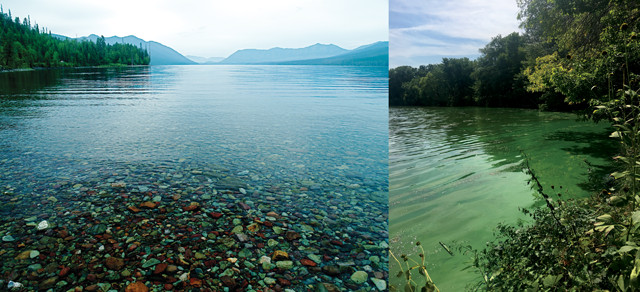
by Mary Caperton Morton Thursday, November 8, 2018

Lake McDonald in Glacier National Park (top) is still clear, but a new study reports that many lakes across the U.S., like Como Lake in Minnesota (above), are getting murkier. Credit: left: Mary Caperton Morton; right: K. Cantner.
A study of more than 1,000 lakes across the United States between 2007 and 2012 found that the number of murky green and brown lakes surpassed the number of clear blue lakes.
Surveys conducted on a random selection of lakes found that the number of blue lakes declined by 18 percent over the five-year time span, while the number of murky lakes increased by 12 percent. Researchers determined lake “true color” using a platinum-cobalt scale, and also calculated total phosphorus levels detected in lake water samples.
The shift isn’t just about color: “Blue lakes typically are those that do not show evidence of nutrient pollution or elevated organic matter while murky lakes have high levels of both,” said lead author Dina Leech of Longwood University in Farmville, Va., in a statement. “A shift toward murkiness is a management concern because murky lakes tend to have more algae, including potentially harmful cyanobacteria. And with poor food quality at the base of the food web, over time, murky lakes may not be able to support a healthy fishery.”
The trend toward murkiness, detected in lakes in a wide variety of ecological settings — from Northern Appalachia to the Southern Plains to the Desert Southwest — is likely caused by regional changes in land-use patterns and hydrology, as well as broader changes in climate, the team wrote in the study, which was published in the journal Limnology and Oceanography.
© 2008-2021. All rights reserved. Any copying, redistribution or retransmission of any of the contents of this service without the expressed written permission of the American Geosciences Institute is expressly prohibited. Click here for all copyright requests.